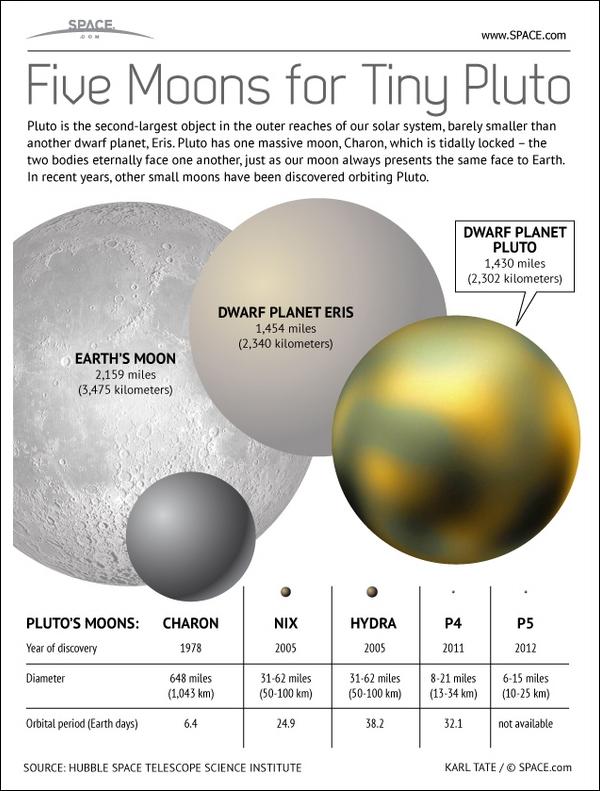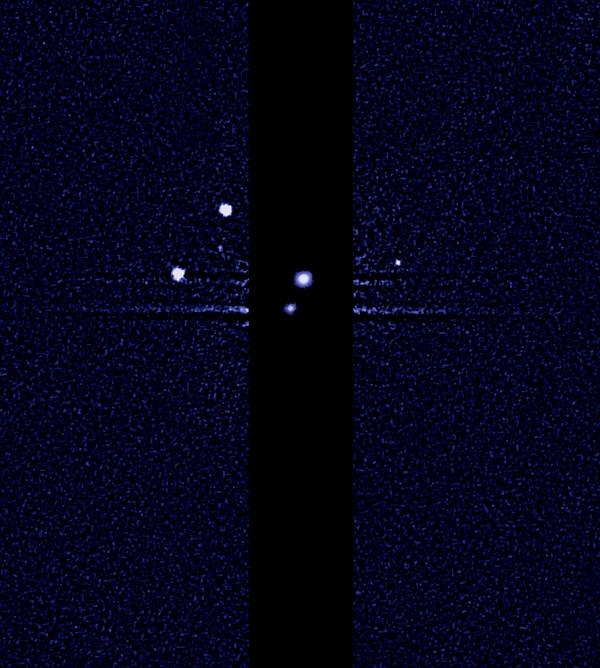Opened the fifth satellite of Pluto
 Bashny.Net
Bashny.Net

The space telescope "Hubble" NASA scientists have noticed tiny new moon orbiting Pluto. The number of known satellites of this dwarf planet has grown to 5.
Fourth friend just opened about a year ago, he still wears boring symbol P4.
On the fifth moon for the first time became known thanks to tweet Alan Stern of the Southwest Research University (USA), principal investigator of the project "New Horizons"; spacecraft with such a name to visit Pluto system in 2015. Nobody really knows what it can expect in the orbit of the dwarf planet, because hard work goes to identify all the bodies dangling around Pluto. "The presence of such a large number of small satellites indirectly indicates that there is probably a lot of small particles, invisible to us," - said project participant Harold Weaver of the Johns Hopkins University (USA). Meanwhile, a spacecraft hurtling at a speed of 13, 4 m / s, can be destroyed even collision with a particle size of the fraction.
If escape from the "New Horizons", that can only wonder how such a small world can be so complex system of satellites. Perhaps this explains the further history of Pluto - for example, a collision with another icy body that occurred billion years ago.
The largest moon of Pluto - Charon (1043 km in diameter), then followed by Nix and Hydra (32 to 113 km). P4 is 13-34 km in diameter.
New moon appears slightly less - 10-24 km - and an irregular shape. The average distance to Pluto - 47 thousand. Km. Orbit at first glance raspolagaetsya in the same plane with the orbits of other satellites. In general, the system looks very neat orbits of nested one inside the other, as in the Matryoshka.
Sputnik was the preliminary designation S / 2012 (134340) 1, but responds and P5. "Hubble" saw through his own third wide-angle camera 26, 27, 29 June, and another 7 and 9 July. A total of 9 sets of images.
After the flight, "New Horizons" Pluto rushed personal opinion Infrared Space Telescope "James Webb Space Telescope." He will be able to measure the chemical properties of the surface of Pluto and its moons, and even almost all other bodies that lie in the distant Kuiper Belt.

Charon noticed for the first time in 1978, 48 years after the discovery of Pluto American Clyde Tombaugh, the staff of United States Naval Observatory. Nix and Hydra were to find "Hubble" in 2005.
Pluto away from the Sun at 5, 87 billion km, in other words, is located about 39 times farther than Earth. For more than 75 years after the discovery of the object considered as a full-fledged planet, but it mutated into 2006, when the International Astronomical Alliance found him a dwarf planet. The fact that Pluto shares orbital space with a huge number of other Kuiper belt objects - rings cold bodies beyond Neptune's orbit. However, the debate last

Tags
See also
"Water World" is found at a distance of 40 light-years
How will the space telescope James Webb
10 latest discoveries in space (11 photos)
10 latest discoveries in space
25 years with the "Hubble"
Beautiful Cat's Eye Nebula (NGC 6543), Space Telescope photographed NA-SA "Hubble".
On Saturn discovered oxygen ions
9 stunned facts about space, we have learned this year
Jupiter is what it is
















